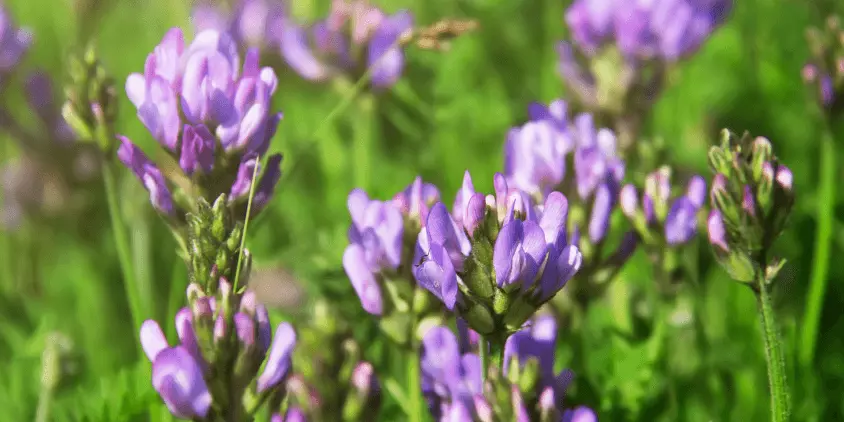
Growing Alfalfa: Cultivation Tips For Successful Farming
Grown as a high-quality forage crop around the world, alfalfa provides nitrogen fixation, increased soil organic matter, and many other benefits. As a result of the plant’s ability to produce two or more harvests per year for several years following initial planting, growing alfalfa results in substantial economic gains. However, realizing the full potential of the crop requires proper planting, management, and care throughout the growing period. To find a happy medium between yield and quality, the timing of your alfalfa harvesting is also crucial. Improved efficiency in sowing, fieldwork, and harvesting planning thanks to the advancement in agricultural technology has led to higher yields and greater revenues from farming alfalfa.
Alfalfa Growing Conditions
Alfalfa (Medicago sativa), or lucerne, is a perennial feed crop yielding the most in its second year. It can grow continuously for 3–4 years in regions with mild winters and 6–9 years in regions with cold winters. It is also cultivated as a short-season plant in crop rotations.
Where Does Alfalfa Grow?
The Mediterranean, presumably, is where alfalfa was initially cultivated. This genuinely global crop may grow in any region with an average daily temperature of at least 41°F (5°C) during the growing season. From the Arctic Circle to the southern tip of South America, it is cultivated on every continent, with major alfalfa growing zones in the USA, Australia, Spain, Canada, and Italy.
Plant Water Requirements
Due to its lengthy growing season, extensive root system, and dense canopy, alfalfa water requirements are high. The amount of water needed for growing the crop depends on environmental factors such as temperature, wind speed, humidity, sun radiation, elevation, soil water-holding capacity, and more. 20 to 46 inches (500 to 1170 mm) of water per growing season is the normal range when discussing how much water alfalfa exactly needs.
Plant Soil Requirements
Although alfalfa soil requirements are not too strict, the plant grows best in deep, well-drained, loamy soil. Soil pH for alfalfa should be between 6.5 and 7.0, as this allows for symbiotic nitrogen fixation. By adding lime, you can bring the acidic soil’s pH up to a desirable level.
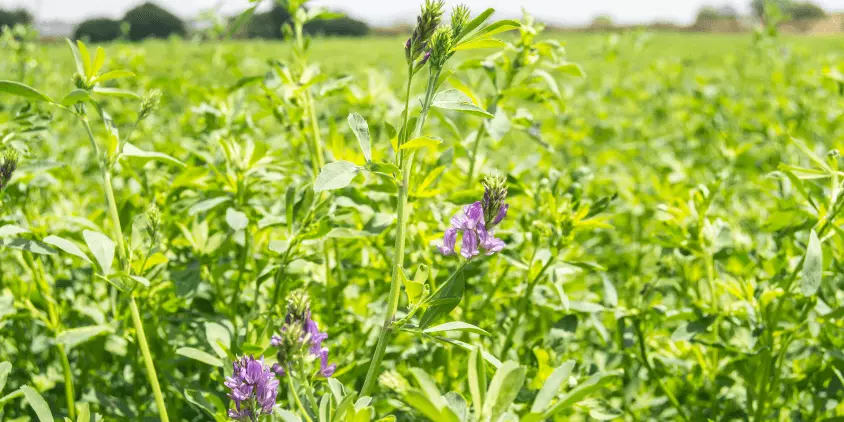
Optimal Temperature And Sunlight
Lucerne needs a minimum of 6 to 8 hours of sunlight per day to grow healthy. At the emerging stage, lucerne has remarkable cold tolerance; nevertheless, this might be misleading. Once the plant grows to the point where it has two ternate leaves, it becomes vulnerable to cold and can perish in as little as four hours if exposed to temperatures below 26°F (-3°C). After reaching the three-ternate-leaf stage, the plant returns to its regular cold tolerance. When temperatures for growing alfalfa in the winter fall below 20°F (-6°C), cut fields go dormant, so they won’t need to be heated or otherwise protected from the cold.
To grow vigorous stands, pay attention to temperature and sunlight regimes and consider them when monitoring crop health. In EOSDA Crop Monitoring, farmers can view daily temperature records for the whole growing region or a single field. You will also have access to the 14-day forecast of temperature and solar radiation, allowing you to make better-informed decisions about when to plant alfalfa.
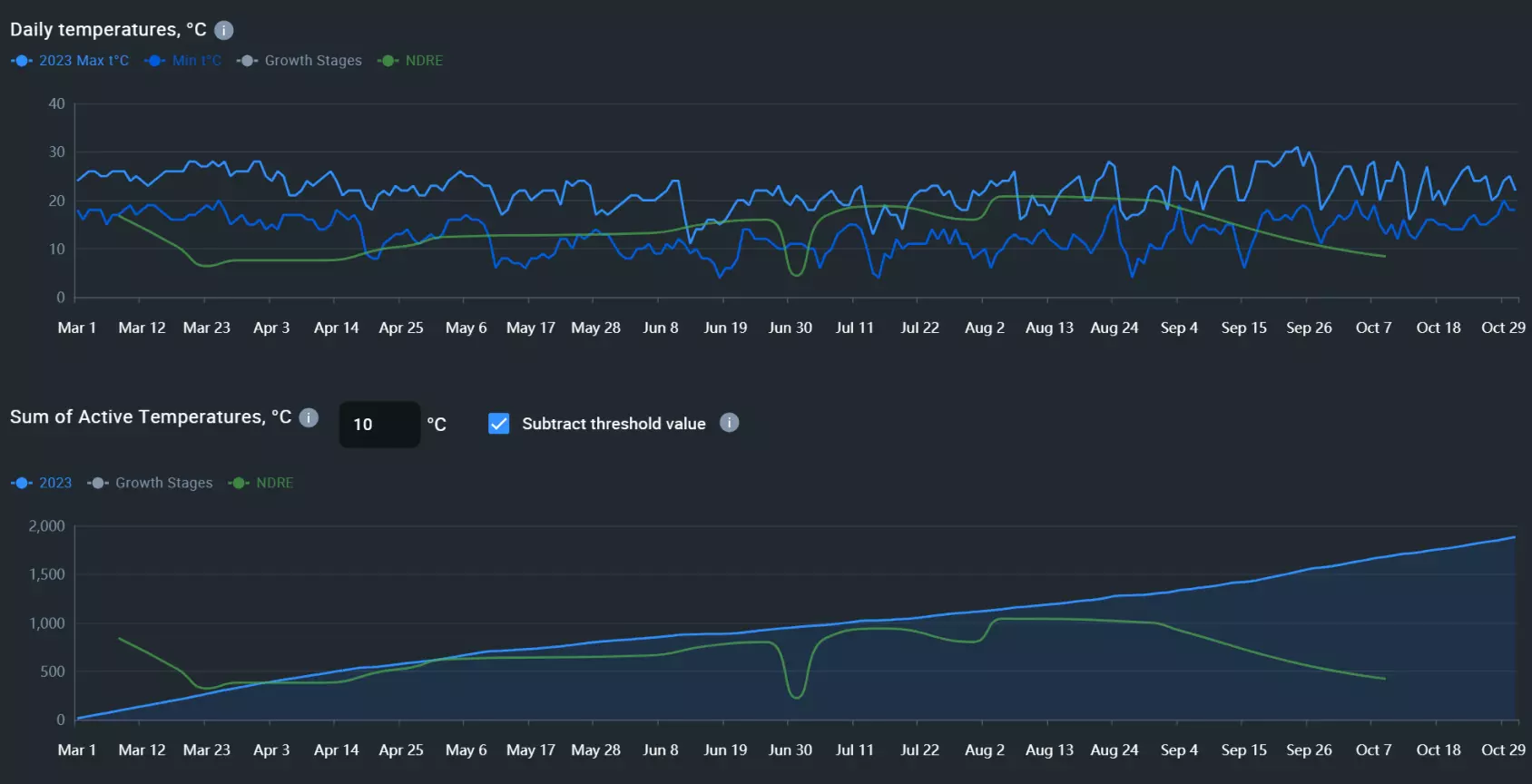
How To Plant Alfalfa
Growing a robust stand requires appropriate planting practices and care for the young seedlings. Consider the following factors before planting alfalfa.
When To Plant Alfalfa
The success of growing young plants and the stand as a whole depends on the timing of alfalfa planting. Temperature, rainfall, and weed pressure are key factors that determine planting dates. Temperatures above 37°F (3°C) are sufficient for plant germination, while the optimal range is between 65 and 77°F (18 and 25°C). Enhanced water transport into the seed and intensified plant metabolic activities cause germination to speed up at higher soil temperatures. The best times to plant alfalfa are spring, late summer, and autumn. Midsummer is not advised due to the intense competition from weeds .
Seeding Alfalfa
The first thing to consider is how deep to plant alfalfa. Sow at a depth of 0.25 inches (0.6 cm) to 0.5 inches (1.2 cm) in clay soil and 0.75 inches (1.9 cm) in sandy soil. Planting alfalfa seeds too shallow may result in poor plant establishment, while planting them too deep may cause seedlings to struggle to germinate.
Using a drill fitted with depth control mechanisms and packer wheels is the most reliable alfalfa sowing method. It is crucial to keep the soil moist after sowing seeds because they need to soak up water equal to around 125% of their weight before swelling and rupturing the seed coat. Sprinkle the soil, but avoid surface or flood watering since it can wash away your seeds.
Companion Planting Vs. Clear Planting
Growing oats or another companion crops (corn or wheat) with lucerne to control weeds, mitigate soil erosion, and give extra yields. Yet, in most cases, growing alfalfa by itself is more fruitful since companion crops typically reduce the alfalfa’s first-year output as well as its stand density.
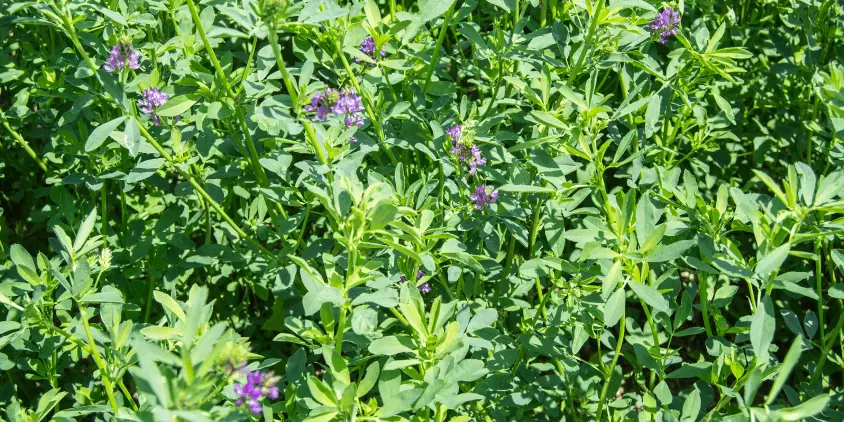
EOSDA Crop Monitoring
Fields analytics tool with access to high-resolution satellite images for remote problem areas identification!
Proper Care For Alfalfa
Proper care is essential for ensuring the longevity and productivity of lucerne stands. Nutrient management and pest control are cornerstones of this care. Last but not least, growing healthy stands entails rotating crops at the right time.
Fertilizing Established Stands
Nitrogen (N), which a plant produces on its own, phosphorus (P), and potassium (K) are the three vital nutrients for growing lucerne. Vegetative growth requires N, whereas root growth requires P. Potassium strengthens plant defenses, increasing crop resistance to environmental stresses and diseases.
The standard alfalfa fertilization recommendations are to apply 18–22 lb/acre (20–25 kg/ha) of phosphorus and 170–218 lb/acre (190–245 kg/ha) of potassium fertilizer. For greater confidence in fertilizer distribution across a field, use the Productivity maps provided by EOSDA Crop Monitoring. Dividing the field into zones based on productivity can help you save money on soil testing while getting the most out of your K and P fertilizer applications for alfalfa.
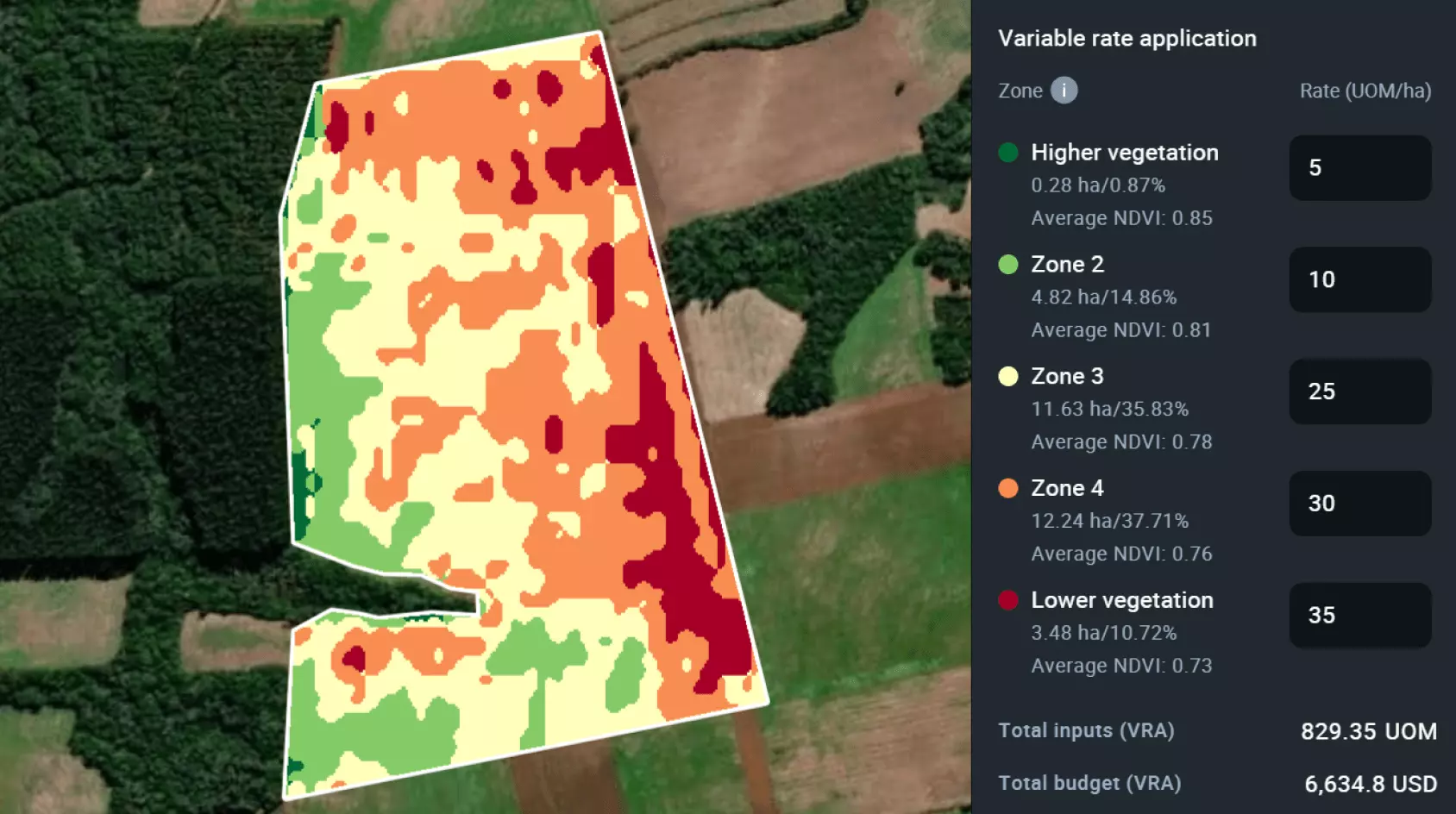
Timely Disease And Pest Control
Alfalfa diseases can negatively impact forage production and quality, as well as stand persistence. Phytophthora root rot can cause stunted regrowth after cutting, whereas Sclerotinia crown and stem rot might result in dramatic failure in a fall-seeded crop. Crown rot and Phytophthora root rot both increase crop susceptibility to harm in the winter .
Without a host plant, most diseases won’t survive. Because of this, rotating crops in the field can reduce pathogen populations as well as prevent alfalfa autotoxicity. Growing lucerne in rotation with cereals and forage grasses with an interval of at least 2 years is preferable. The Crop rotation feature in our platform might be useful for consolidating information across all fields and years.

Low population density, which is most common for alfalfa pests, can’t impact crop production significantly. There are times, though, when pest populations grow too high and threaten crop success. Because of the pest and disease risks, fields must be thoroughly examined weekly throughout the growing season.
This may be done with less effort and expense thanks to the Scouting feature in EOSDA Crop Monitoring. Based on the information provided by vegetation indices, you can send a scout out to investigate the situation in the particular area in question. The scout’s report on the platform will provide you with a sense of the field condition, allowing you to make informed decisions about whether or not any control measures are necessary.

How Long Does Alfalfa Take To Grow?
Some lucerne varieties can reach maturity in as little as 6 weeks after being planted from seed. However, many species take anything from six months to two years to grow mature. When it comes to forage quality, it’s vital to remember that how tall alfalfa grows has a greater impact on quality than how long it grows. When alfalfa height reaches a minimum of 15 inches (38 cm), often about 40 days following germination in ideal growing conditions, the crop is ready for its first cutting.
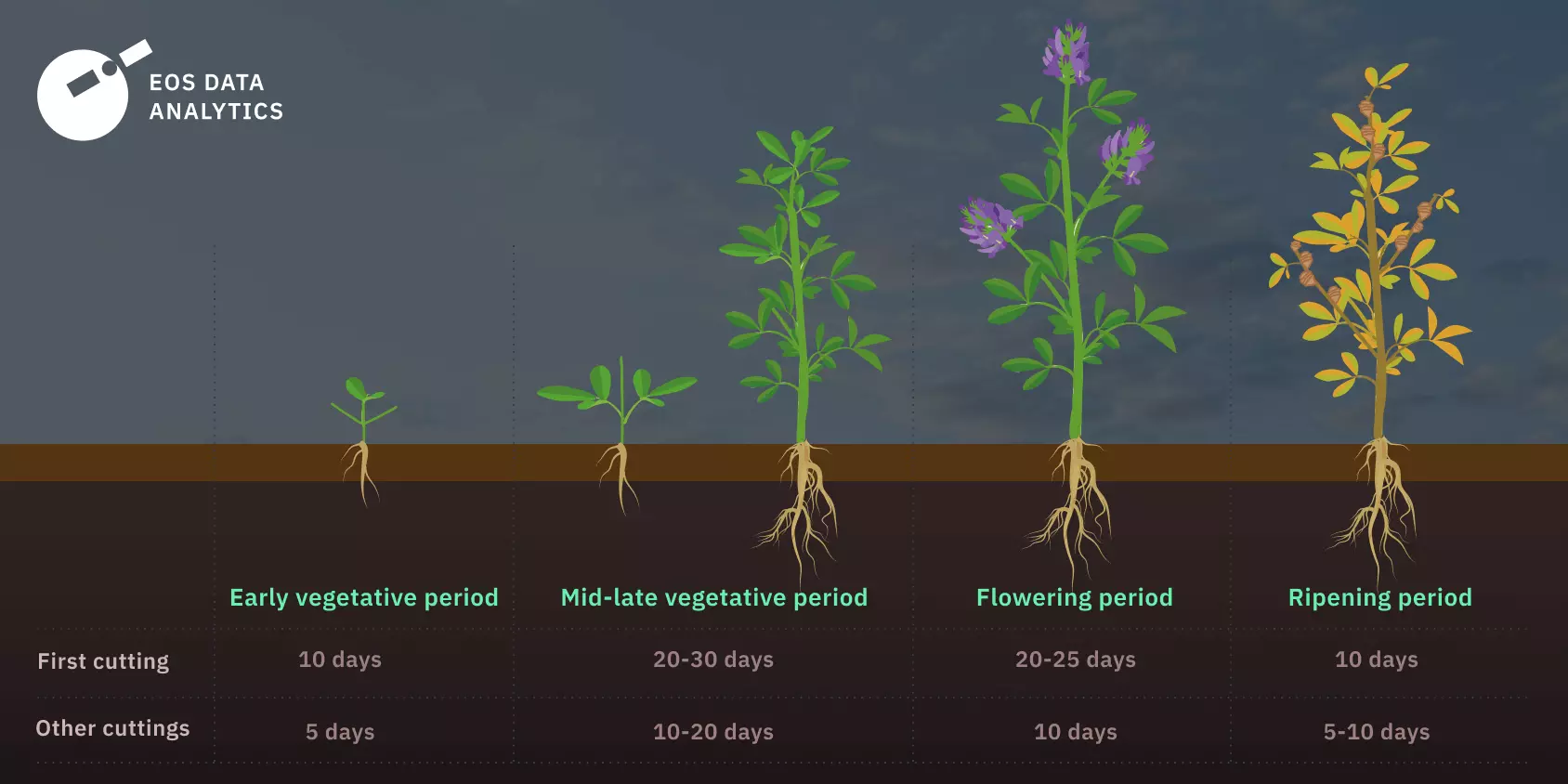
How To Harvest Alfalfa
Given sufficient precipitation and soil nutrient levels, spring-sown lucerne can be harvested twice in its first year and even more in the following growing years, with yields surpassing 7-8 t/ac (17-20 t/ha) of hay equivalent. Careful cutting management can extend the usable life of disease-resistant cultivars to over five years.
First Cutting
Seedlings must store a lot of energy to make it through the harsh winter. Even though the plant can be harvested for the first time before it blooms (60–70 days upon emergence), doing so will result in less energy for growing stored in the roots.
When harvested timely, alfalfa can supply high-quality fodder and ample root reserves for subsequent stand growth. If you cut too late, quality suffers but yields grow, and if you cut too early, quality is maintained but yields and stand longevity suffer. While research suggests that in the 10% bloom stage, yield, forage quality, and stand life are most likely to be in balance, the decision on when to cut alfalfa is strongly dependent on the specific lucerne variety, local growing conditions, and farmer objectives .
The NDRE index, which is readily available in EOSDA Crop Monitoring, is particularly useful to farmers in determining if the crop is in its optimal state for harvesting to accomplish farmer objectives. For the most precise results, growers should use the NDRE rather than the NDVI in the middle to late stages of the growing season.
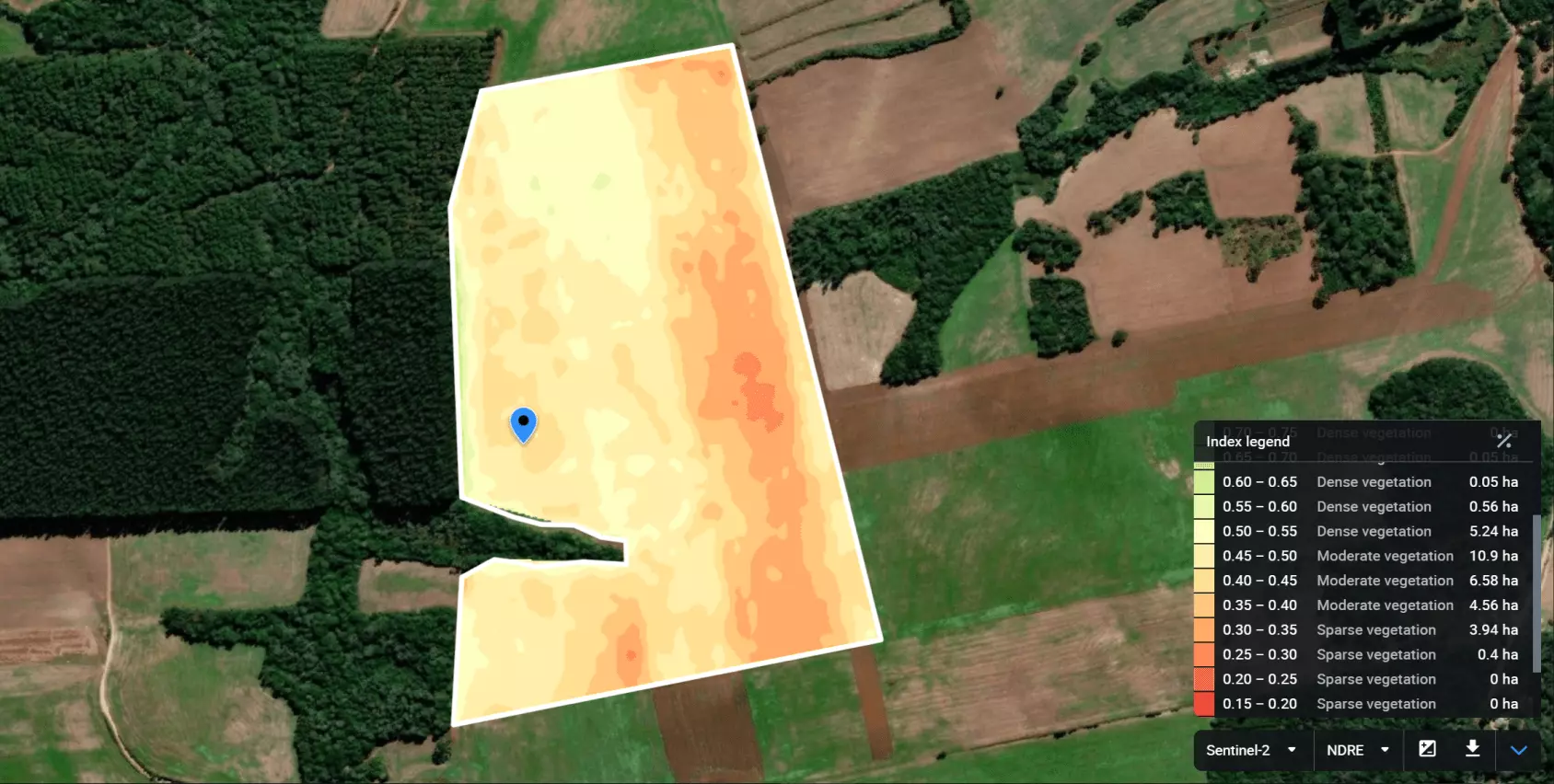
Second Cutting
Faster growth and a higher stem-to-leaf ratio are typical of a second-cut crop since it matures during the hottest months of the growing season. To give the plants ample time to store adequate energy for the upcoming winter, the best time to harvest alfalfa for the second time is either before the start of autumn, shortly following the first killing frost of 24°F (-4°C), or sometime after mid-October.
There may be even a third alfalfa cutting if the second one is completed before autumn and the growing conditions are ideal, but this must wait until there is a clear killing frost. A 6-inch (15-cm) tall stubble must be left in the field after harvesting in the middle of October or later to shield the crowns and trap snow for extra insulation. When harvesting lucerne after a companion crop, follow the same steps as you would if there had been no companion crop.
Every alfalfa farming professional strives to increase crop yield and quality for the best possible financial return without compromising stand longevity. If you plant the crop properly, care for it meticulously, and harvest it at the right time, you can get the most out of alfalfa cultivation.
About the author:
Vasyl Cherlinka is a Doctor of Biosciences specializing in pedology (soil science), with 30 years of experience in the field. He attended the engineering college in Ukraine and received his degree in agrochemistry, agronomy and soil science in the Chernivtsi National University. Since 2018, Dr. Cherlinka has been advising EOSDA on problems in soil science, agronomy, and agrochemistry.
Recent articles

Analyze 2025 & Plan Your Best Year Yet: LandViewer Christmas Offer
It’s the most wonderful time of the year! The Christmas holidays are here, and so is your chance to analyze 2025 and plan a prosperous 2026 with more affordable Pro plans in LandViewer.

EOSDA Models Climate Change Impact On Sugarcane Yields
EOSDA modeled future temperature, rainfall, and other climate impacts on Veracruz sugarcane. The results help growers plan long-term adaptation strategies, including timing, varieties, and irrigation.

EOSDA LandViewer Black Friday Sale: Exclusive Offers & Giveaway
This Black Friday, LandViewer offers new users the chance to save on monthly plans, get extra months with yearly subscriptions, and participate in a free annual plan giveaway.